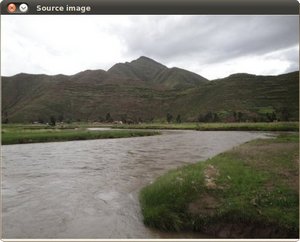 |
OpenCV 4.13.0-dev
Open Source Computer Vision
|
 |
OpenCV 4.13.0-dev
Open Source Computer Vision
|
Prev Tutorial: Remapping
Next Tutorial: Histogram Equalization
| Original author | Ana Huamán |
| Compatibility | OpenCV >= 3.0 |
In this tutorial you will learn how to:
From the above, we can use an Affine Transformation to express:
you can see that, in essence, an Affine Transformation represents a relation between two images.
The usual way to represent an Affine Transformation is by using a \(2 \times 3\) matrix.
\[ A = \begin{bmatrix} a_{00} & a_{01} \\ a_{10} & a_{11} \end{bmatrix}_{2 \times 2} B = \begin{bmatrix} b_{00} \\ b_{10} \end{bmatrix}_{2 \times 1} \]
\[ M = \begin{bmatrix} A & B \end{bmatrix} = \begin{bmatrix} a_{00} & a_{01} & b_{00} \\ a_{10} & a_{11} & b_{10} \end{bmatrix}_{2 \times 3} \]
Considering that we want to transform a 2D vector \(X = \begin{bmatrix}x \\ y\end{bmatrix}\) by using \(A\) and \(B\), we can do the same with:
\(T = A \cdot \begin{bmatrix}x \\ y\end{bmatrix} + B\) or \(T = M \cdot [x, y, 1]^{T}\)
\[T = \begin{bmatrix} a_{00}x + a_{01}y + b_{00} \\ a_{10}x + a_{11}y + b_{10} \end{bmatrix}\]

the points 1, 2 and 3 (forming a triangle in image 1) are mapped into image 2, still forming a triangle, but now they have changed notoriously. If we find the Affine Transformation with these 3 points (you can choose them as you like), then we can apply this found relation to all the pixels in an image.
Load an image:
Affine Transform: As we explained in lines above, we need two sets of 3 points to derive the affine transform relation. Have a look:
You may want to draw these points to get a better idea on how they change. Their locations are approximately the same as the ones depicted in the example figure (in the Theory section). You may note that the size and orientation of the triangle defined by the 3 points change.
Armed with both sets of points, we calculate the Affine Transform by using OpenCV function cv::getAffineTransform :
We get a \(2 \times 3\) matrix as an output (in this case warp_mat)
We then apply the Affine Transform just found to the src image
with the following arguments:
We just got our first transformed image! We will display it in one bit. Before that, we also want to rotate it...
Rotate: To rotate an image, we need to know two things:
We define these parameters with the following snippet:
We generate the rotation matrix with the OpenCV function cv::getRotationMatrix2D , which returns a \(2 \times 3\) matrix (in this case rot_mat)
We now apply the found rotation to the output of our previous Transformation:
Finally, we display our results in two windows plus the original image for good measure:
We just have to wait until the user exits the program

after applying the first Affine Transform we obtain:

and finally, after applying a negative rotation (remember negative means clockwise) and a scale factor, we get:
